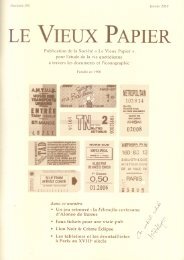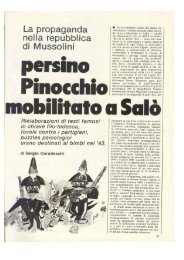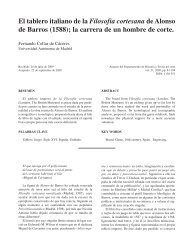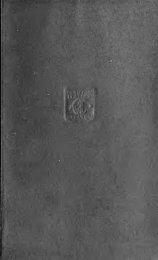Board games from the city of Vijayanagara (Hampi ... - Gioco dell'Oca.
Board games from the city of Vijayanagara (Hampi ... - Gioco dell'Oca.
Board games from the city of Vijayanagara (Hampi ... - Gioco dell'Oca.
Create successful ePaper yourself
Turn your PDF publications into a flip-book with our unique Google optimized e-Paper software.
T. D EPAULIS, UN JEU DE PIONS MAPUCHE AU XVI e SIÈCLE<br />
If <strong>the</strong>y fall all white, this who gets <strong>the</strong>m moves forward by 4 cells, moving <strong>from</strong> <strong>the</strong> cells<br />
on <strong>the</strong> side towards <strong>the</strong> o<strong>the</strong>r cell, that is <strong>the</strong> larger one. If <strong>the</strong>y fall all black, he moves<br />
forward by 3 cells with <strong>the</strong> same stone (…). If he gets two white and two black [faces],<br />
he moves forward by 1 cell. If he gets one black and three whites or three blacks and one<br />
white, he loses his turn and <strong>the</strong> o<strong>the</strong>r opponent plays and moves forward in <strong>the</strong> same way<br />
according to what he gets.<br />
This stone makes its way along <strong>the</strong> cells where <strong>the</strong>re are o<strong>the</strong>r stones; if one finds oneself<br />
getting into <strong>the</strong> larger cell that is on <strong>the</strong> tops <strong>of</strong> <strong>the</strong> Cs, one loses one’s turn. Once<br />
<strong>the</strong>re, this stone wins over its opponent. This win being made, it comes out <strong>the</strong>re towards<br />
<strong>the</strong> opponent’s stones and takes as many <strong>of</strong> <strong>the</strong>m as <strong>the</strong>re are cells which it comes to,<br />
according to <strong>the</strong> cast [<strong>of</strong> dice beans]. If, being in <strong>the</strong> larger cell, he loses <strong>the</strong> stone, that<br />
is why <strong>the</strong>y say it is a river and one drowns <strong>the</strong>re. He <strong>the</strong>n plays with <strong>the</strong> o<strong>the</strong>r [stone]<br />
that remains on his side. If <strong>the</strong>y “kill” it with <strong>the</strong> o<strong>the</strong>r side’s stone [= if <strong>the</strong> opponent<br />
captures this stone], <strong>the</strong>y play thus. This who, before <strong>the</strong> o<strong>the</strong>r, “kills” and drives out <strong>of</strong><br />
<strong>the</strong>ir cells <strong>the</strong> opponent’s ten stones wins <strong>the</strong> pot.<br />
This is <strong>the</strong>ir game and <strong>the</strong>y have no o<strong>the</strong>r. They are great gamblers, and even <strong>the</strong>y<br />
<strong>of</strong>ten wager <strong>the</strong>ir wives and children. These [wives] are greatly addicted to this game<br />
and <strong>the</strong>y wager what <strong>the</strong>y possess.<br />
Bibliographie<br />
Cooper, John M. 1949. Games and gambling, In: J.H. Steward (éd.), Handbook <strong>of</strong> South-<br />
American Indians, vol. 5: The comparative ethnology <strong>of</strong> South-American Indians,<br />
Washington, D.C. (réimpr. 1963): 503-524.<br />
Depaulis, Thierry 1998. Inca dice and board <strong>games</strong>, In: <strong>Board</strong> Games Studies, 1: 26-49.<br />
Gentile Lafaille, Margarita E. 1998. La pichca: oráculo y juego de fortuna (su persistencia<br />
en el espacio y tiempo andinos), In: Bulletin de l’Institut Français d’Études Andines,<br />
27 (1): 75-131 (repris dans Id., Huacca Muchay, religión indígena: religión, creencias,<br />
juegos área andina argentina prehispánica, colonial, actual, Buenos Aires, 1999<br />
(Trabajos del INSPF; 2), chap. 6: 255-329).<br />
Hawtrey, Seymour H.C. 1901. The Lengua Indians <strong>of</strong> <strong>the</strong> Paraguayan Chaco, In: The<br />
Journal <strong>of</strong> <strong>the</strong> Royal Anthropological Institute <strong>of</strong> Great-Britain and Ireland, XXXI: 297.<br />
Karsten, Rafael 1930. Ceremonial <strong>games</strong> <strong>of</strong> <strong>the</strong> South-American Indians. Helsinki (Societas<br />
Scientarum Fennica. Commentationes Humanarum Litterarum, III, 2).<br />
Nordenskiöld, Erland 1910. Spiele und Spielsachen im Gran Chaco und in<br />
Nordamerika, Zeitschrift für Ethnologie, 42: 427-433.<br />
Nordenskiöld, Erland 1918. Spieltische aus Peru und Ecuador, Zeitschrift für Ethnologie,<br />
50: 166-171.<br />
Orellana Rodríguez, Mario 1988. Gerónimo de Bibar y la Conquista de Chile. Santiago<br />
de Chile, Editorial Universitaria.<br />
Rosen, Eric von 1924. Ethnographical research work during <strong>the</strong> Swedish Chaco-Cordillera<br />
expedition 1901-1902, Stockholm.<br />
Vivante, Armando 1944. Un juego de azar indígena, Revista Geográfica Americana, XIe<br />
année, vol. XXI, n° 127: 213-216.<br />
93







